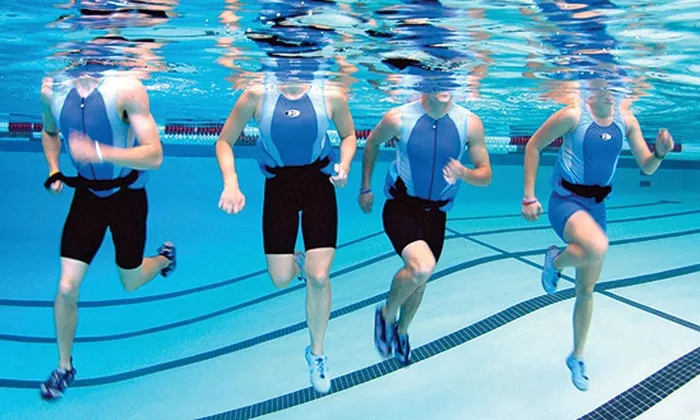Aqua jogging, also known as water running, is an excellent form of exercise that combines the cardiovascular benefits of running with the low-impact advantages of water workouts. It’s an effective way to stay fit, improve endurance, and aid in injury recovery. This comprehensive guide will walk you through how to do aqua jogging, including its benefits, equipment, techniques, and tips for getting the most out of your workouts.
Benefits of Aqua Jogging
Low Impact on Joints
One of the most significant benefits of aqua jogging is the reduced impact on your joints. Water provides natural buoyancy, which supports your body and minimizes stress on your knees, hips, and ankles. This makes aqua jogging an ideal exercise for individuals with arthritis, joint pain, or those recovering from injuries.
Improved Cardiovascular Fitness
Aqua jogging is an excellent cardiovascular workout. The resistance of the water requires more effort to move, which increases your heart rate and improves cardiovascular endurance. It’s a great way to get a high-intensity workout without the strain of traditional running.
Enhanced Muscle Strength and Tone
The resistance provided by water works all the major muscle groups. Aqua jogging engages your core, legs, arms, and back, helping to build muscle strength and improve overall muscle tone. This resistance training is also beneficial for improving balance and stability.
Increased Caloric Burn
Due to the resistance of the water, aqua jogging can burn more calories than land-based running. This makes it an effective exercise for weight loss and weight management. The exact number of calories burned depends on the intensity of your workout, but it’s generally higher than traditional jogging.
Versatility and Accessibility
Aqua jogging is suitable for people of all fitness levels and ages. Whether you are a beginner looking to start a new fitness routine or an athlete seeking to cross-train, aqua jogging can be adapted to meet your needs. It’s also accessible for those with limited mobility or chronic conditions that make high-impact exercises challenging.
Essential Equipment for Aqua Jogging
Aqua Jogging Belt
An aqua jogging belt is a crucial piece of equipment. It provides buoyancy and helps maintain an upright position in the water, allowing you to focus on your jogging technique. The belt should fit snugly around your waist and keep you afloat without causing discomfort.
Water Shoes
Water shoes are recommended to protect your feet and provide better traction in the pool. They also offer support and reduce the risk of slipping. Look for shoes that are lightweight, quick-drying, and have a good grip on the sole.
Appropriate Swimwear
Wearing appropriate swimwear is essential for comfort and freedom of movement. Opt for a swimsuit that fits well and doesn’t restrict your motion. For added comfort, you can wear a rash guard or a swim shirt.
Additional Equipment
While not essential, additional equipment like water gloves or resistance gloves can increase the intensity of your workout by adding more resistance. Waterproof headphones and a waterproof music player can make your sessions more enjoyable.
Getting Started with Aqua Jogging
Choosing the Right Pool
The first step to starting aqua jogging is finding the right pool. Look for a pool with a depth of at least 4-5 feet to ensure you can jog without touching the bottom. Some pools offer designated lanes for water exercises, which can be beneficial if you prefer a more structured environment.
Warming Up
As with any exercise, warming up is essential. Begin with 5-10 minutes of light swimming or water walking to gradually increase your heart rate and prepare your muscles for the workout. This will help prevent injuries and improve your overall performance.
See Also: The Top 5 Ellipticals: A Comprehensive Guide
Proper Aqua Jogging Technique
Proper technique is crucial for maximizing the benefits of aqua jogging and preventing injuries. Here are the key points to keep in mind:
Posture
Maintain an upright posture with your head above the water and your body aligned. Avoid leaning too far forward or backward.
Leg Movement
Mimic the motion of running on land. Lift your knees high, extend your legs forward, and push back with your feet. Focus on making controlled and deliberate movements.
Arm Movement
Move your arms in a running motion, bending your elbows at a 90-degree angle. Swing your arms back and forth to help maintain balance and increase the intensity of your workout.
Breathing
Practice deep, rhythmic breathing. Inhale through your nose and exhale through your mouth. The resistance of the water can make breathing more challenging, so it’s essential to find a comfortable rhythm.
Types of Aqua Jogging Workouts
Steady-State Jogging
Steady-state jogging involves maintaining a consistent pace throughout your workout. It’s an excellent way to build endurance and improve cardiovascular fitness. Aim for a duration of 20-45 minutes, depending on your fitness level.
Interval Training
Interval training alternates between high-intensity jogging and low-intensity recovery periods. This type of workout is effective for boosting metabolism and burning calories. A typical interval session might include 1 minute of intense jogging followed by 2 minutes of light jogging or water walking.
Fartlek Training
Fartlek, or “speed play,” is a less structured form of interval training. It involves varying your speed and intensity throughout the workout based on how you feel. For example, you might sprint to one end of the pool and then jog back at a moderate pace.
Hill Training
Simulate hill training by incorporating high knees or skipping motions to increase the intensity. This type of workout targets your leg muscles and improves strength and power.
Cross-Training
Combine aqua jogging with other water exercises such as swimming, water aerobics, or resistance training. This approach adds variety to your workouts and targets different muscle groups.
Tips for Effective Aqua Jogging
Set Goals
Set specific, measurable goals for your aqua jogging workouts. Whether it’s improving endurance, increasing speed, or losing weight, having clear goals will keep you motivated and focused.
Monitor Intensity
Use a waterproof heart rate monitor or the perceived exertion scale to ensure you are working out at the right intensity. Aim for a heart rate of 60-80% of your maximum heart rate for a moderate-intensity workout.
Stay Hydrated
Even though you are in the water, it’s essential to stay hydrated. Drink plenty of water before, during, and after your workout to prevent dehydration.
Cool Down
End your session with a cool-down period to gradually lower your heart rate and relax your muscles. Spend 5-10 minutes doing light swimming or water walking, followed by gentle stretching exercises.
Listen to Your Body
Pay attention to how your body feels during and after your workouts. If you experience pain or discomfort, adjust your technique or intensity. It’s essential to avoid overtraining and allow your body time to recover.
Common Mistakes to Avoid
Incorrect Posture
Maintaining proper posture is crucial for effective aqua jogging. Avoid leaning too far forward or backward, as this can strain your lower back and reduce the effectiveness of your workout.
Overstriding
Overstriding, or taking too long strides, can cause you to lose balance and reduce the efficiency of your movements. Focus on making controlled, deliberate steps.
Holding Your Breath
Holding your breath can make your workout more challenging and lead to fatigue. Practice deep, rhythmic breathing to ensure a steady oxygen supply to your muscles.
Inconsistent Intensity
Inconsistent intensity can hinder your progress and reduce the benefits of your workout. Aim for a consistent effort level throughout your session, adjusting the intensity as needed for different types of workouts.
Incorporating Aqua Jogging into Your Fitness Routine
Frequency and Duration
For optimal results, aim to incorporate aqua jogging into your fitness routine 2-3 times per week. Each session should last between 30-60 minutes, depending on your fitness level and goals.
Combining with Other Exercises
Aqua jogging can be an excellent complement to other forms of exercise. Combine it with land-based running, strength training, and flexibility exercises for a well-rounded fitness routine. This approach helps prevent overuse injuries and keeps your workouts interesting.
Tracking Progress
Keep a workout journal to track your progress. Record the duration, intensity, and type of each session, as well as any notes on how you felt during the workout. This information can help you adjust your routine and set new goals.
Advanced Aqua Jogging Techniques
Deep Water Running
Deep water running involves jogging in the deeper part of the pool, where your feet do not touch the bottom. This technique provides maximum resistance and engages your core muscles more intensely. It’s an excellent way to increase the difficulty of your workouts and challenge your balance.
Weighted Aqua Jogging
For an added challenge, incorporate waterproof ankle or wrist weights into your routine. The extra resistance will increase the intensity of your workout and help build strength. Start with light weights and gradually increase as you become more comfortable.
High-Intensity Interval Training (HIIT)
Incorporate high-intensity interval training (HIIT) into your aqua jogging routine for maximum calorie burn and cardiovascular benefits. Alternate between short bursts of maximum effort and longer recovery periods. For example, sprint for 30 seconds, then jog at a moderate pace for 1-2 minutes.
Cross-Training with Aqua Aerobics
Combine aqua jogging with aqua aerobics exercises to create a dynamic and varied workout. Include moves like water treading, leg lifts, and arm curls to target different muscle groups and keep your workouts engaging.
Conclusion
Aqua jogging is a versatile, low-impact exercise that offers numerous benefits for people of all fitness levels. Whether you’re looking to improve cardiovascular fitness, recover from an injury, or simply add variety to your workout routine, aqua jogging is an excellent choice. By following the techniques and tips outlined in this guide, you can make the most of your aqua jogging sessions and achieve your fitness goals. Remember to listen to your body, stay hydrated, and enjoy the refreshing and invigorating experience of exercising in the water.
[inline_related_posts title=”You Might Be Interested In” title_align=”left” style=”list” number=”6″ align=”none” ids=”10610,10460,10396″ by=”categories” orderby=”rand” order=”DESC” hide_thumb=”no” thumb_right=”no” views=”no” date=”yes” grid_columns=”2″ post_type=”” tax=””]


































